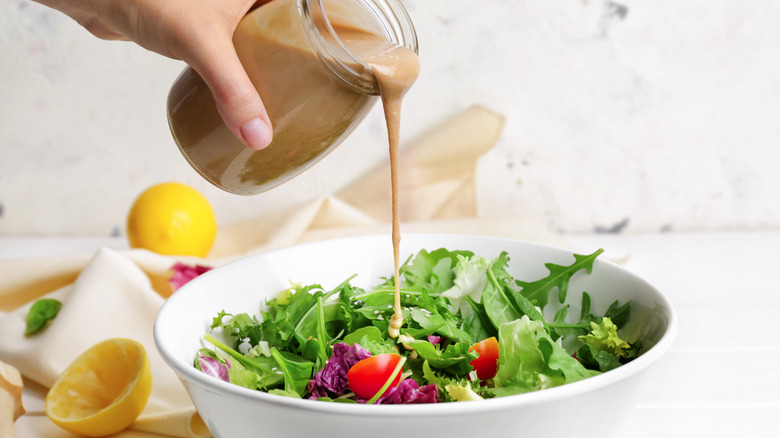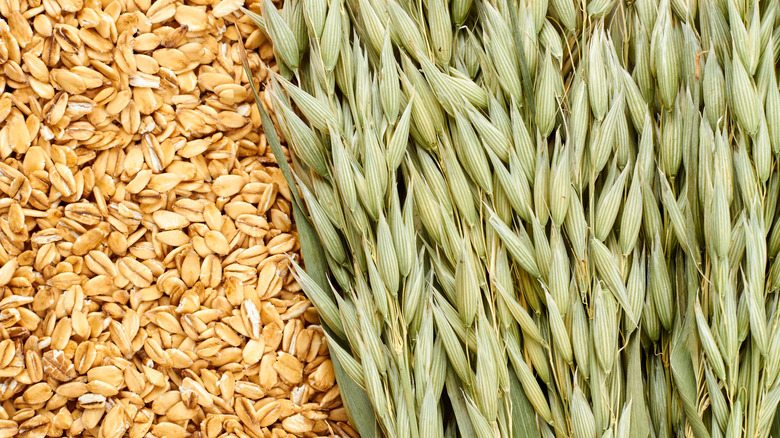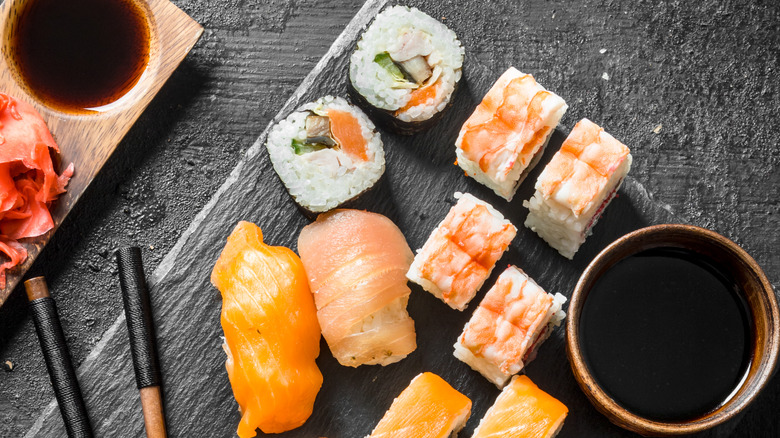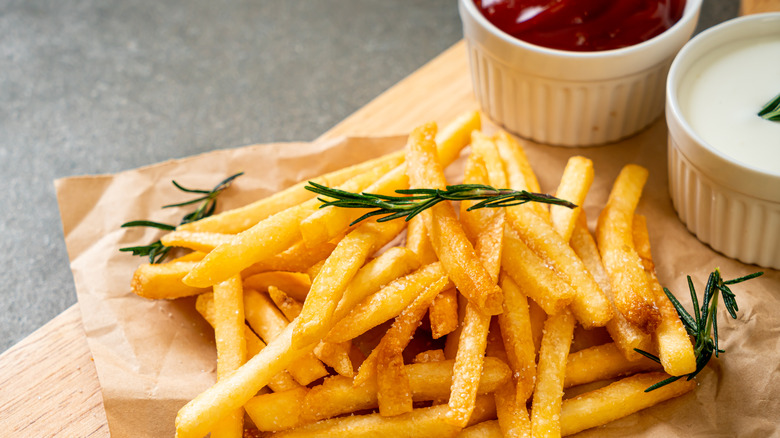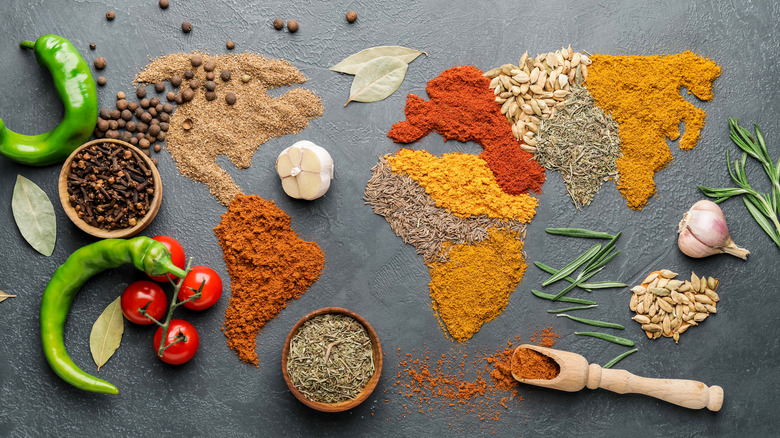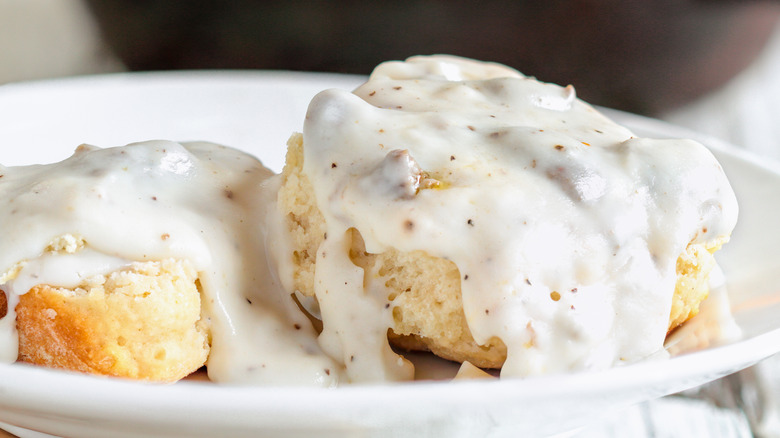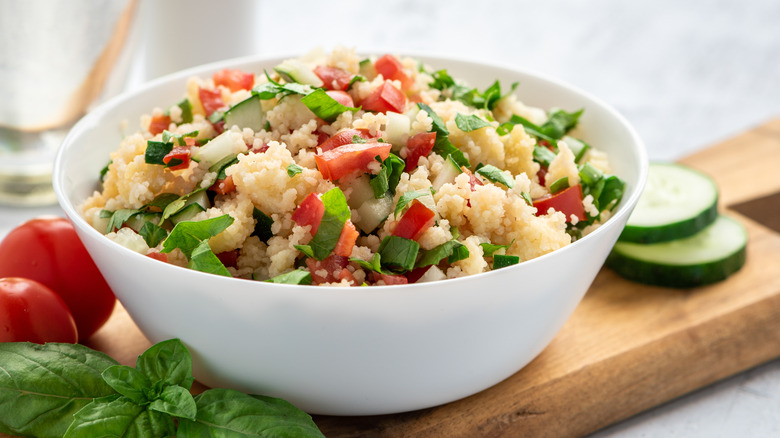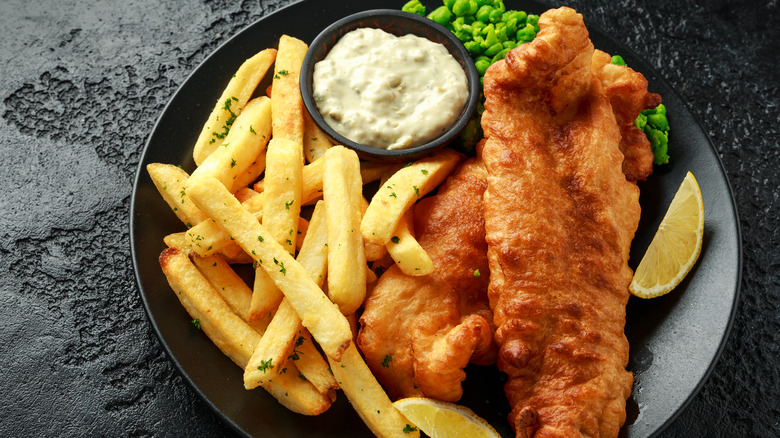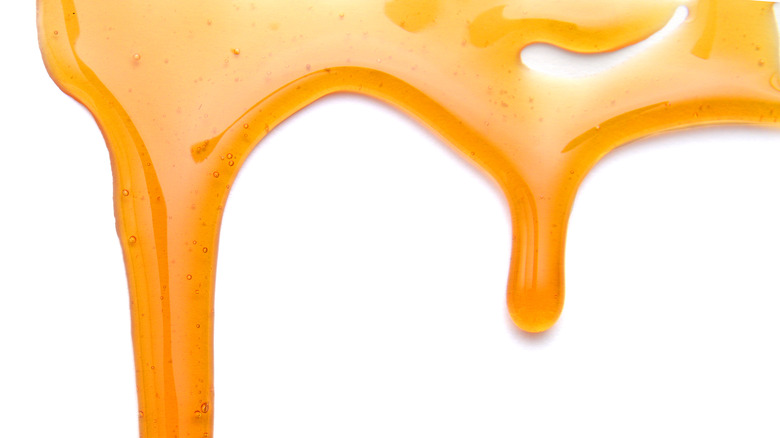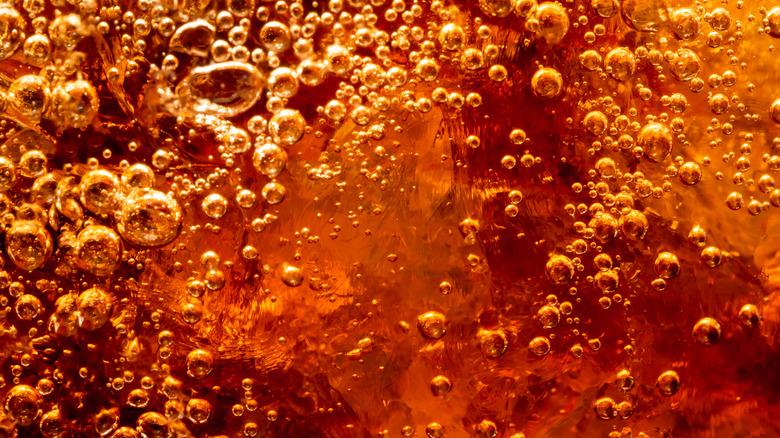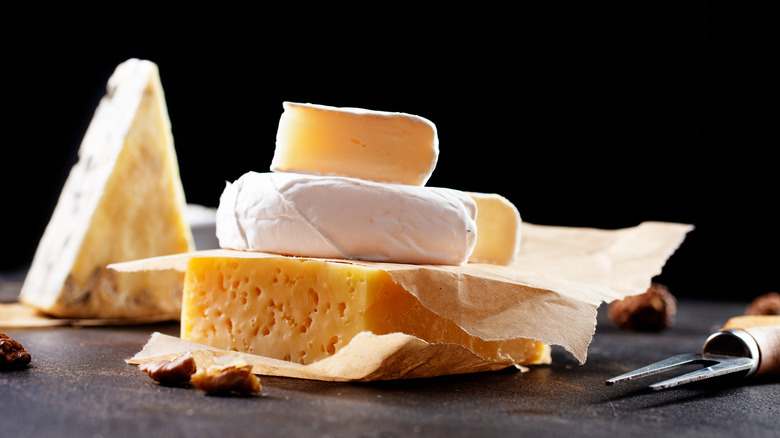Foods You'd Be Surprised Aren't Gluten Free
The gluten-free lifestyle has continued to gain popularity, as more and more people find themselves enjoying the way their bodies feel devoid of wheat. That has to be it, right? It cannot possibly be because people simply enjoy bypassing life's greatest joys, e.g., a plethora of butter croissants, a glazed donut, or a bowl of pasta. Whatever your reason for jumping on the gluten-free train may be, it can feel overwhelming at first. This is especially true if you are blindsided by a celiac disease diagnosis, or news of another illnesses that requires you to omit that tasty little gluten protein.
Celiac disease is an autoimmune disease that flares up when the person in question consumes gluten or even a gluten particle, depending on how sensitive they are. People with celiac disease, especially the newly diagnosed, often feel like they spend their lives nitpicking food labels, interrogating servers, and engaging in otherwise cagey behavior around meal time with other people (via Everyday Health). All of that can be a lot to cope with, especially in the face of such a stark and necessary lifestyle change. Whether it is you or someone in your life who has to operate as if gluten is a kryptonite, we pulled together a cheat sheet for you. Here is a roundup of popular foods that you might be surprised to learn are not gluten free.
Licorice
To our knowledge, there isn't a huge sector of people running around proclaiming how much they love licorice. Until, that is, they are told that they cannot have it ever again. While there are some paltry, off-brand, gluten-free licorices on the market, your standard movie theater Red Vines (as well as others) contain gluten (per The Philadelphia Inquirer).
Wheat flour is often the second ingredient in licorice, which is disappointing if you like chowing down on "candy" that tastes like motor oil and looks like a dirty, congealed version of the stuff. Gluten is the binding protein in wheat, which is why it is often added as a secondary ingredient to packaged foods. It can help these foods stay together and provide a better texture (via Journal of Gastroenterology and Hepatology).
If you have ever bitten into a gluten-free cookie and noticed that it has a chalk-like texture, you get it. Regular cookies contain ooey-gooey gluten to help them melt in your mouth instead of crumble all over the front of your shirt and leave you desperate for a Gatorade.
Salad dressings
It feels kind of hard to conceptualize liquids, especially those that are not fermented from wheat or barley, having gluten in them. But alas, some of them do. Namely, salad dressings are iconic for having sneaky gluten lurking in their tasty depths.
The good news is that most vinaigrettes are gluten free, though you should always scour the label before indulging in salad sauce. Sometimes, the manufacturers will add in sneaky names that might lead you to believe a salad dressing is gluten free. For example, dextrin, artificial colors, natural flavorings, malt, malt vinegar, and food starch might all be derived from gluten. Since there is no hard-and-fast rule surrounding these ingredients, it is best to do your due diligence and research when it comes to eating dressings containing these ingredients (via Gluten Free Living).
Moreover, thicker style dressings like ranch can have straight-up wheat flour in them as a thickener (per Today's Dietitian). When in doubt, opt out of dressings you're unsure of — and instead, reach for one that carries a certified gluten free label.
Oats
Oats are not a part of the gluten family, which is why they are so sneaky when it comes to their gluten-containing-ness. Oats do contain a protein that is similar in chemical structure to the gluten protein. However, very few people with celiac disease react to that protein. Since some do, it is valuable to determine where you stand on this spectrum with the help of your doctor.
The biggest issue with oats is that they are, more often than not, contaminated by gluten. As mentioned, gluten is the binding protein in wheat. Thus, anything that comes into close contact with wheat will end up with gluten molecules stuck to them. Cross-contamination occurs through shared storage or processing on the same equipment. There are quite a few options for purchasing oats that are carefully segregated to avoid cross-contamination. Studies to prove that uncontaminated oats are safe for patients have shown that those who eat oats do not generally have negative effects. Even more interestingly, some studies have shown that people with celiac disease who eat oats every day have better intestinal healing than those who do not eat them (via Healthline).
Soy sauce
Going out for sushi as a gluten-free person is usually a safe bet. After all, at its core, sushi and rice are totally gluten free. But the more ubiquitous sushi condiment of them all can spell disaster for people who are unable to tolerate gluten.
Some people are generally aware that wheat is included in soy sauce. Soy sauce is a fermented condiment that is made by combining soy and wheat and letting it ferment and create mold in a salty liquid, hence the tangy and salty flavors. Sadly, this means that people following a gluten-free diet can't dip their sushi (and, well, pretty much anything else they're eating) in it.
Fortunately, there's a gluten-free option. Also known as tamari, it tastes nearly identical to plain ol' soy sauce, but doesn't contain wheat (via Everyday Health). While gluten-free soy sauce is made through the same process, wheat isn't added to it, making it a safe option for people with celiac disease (via Healthline).
French fries
For people who are not in the know, it is easy to transpose the words "gluten," "carbs," and "starches." This can sometimes turn into the notion that potatoes and rice and not gluten free, both of which are. However, potatoes in all forms are not gluten free, especially when it comes to the deliciously fried versions of our favorite spuds. When preparing fries at home, you can be sure that they are naked potatoes, a bit of oil, and some salt. It is eating out that starts to get tricky.
If you are lucky enough to dine in an establishment that has a dedicated gluten-free fryer, your gluten-free needs will be met. In most restaurants, though, all kinds of floured and breaded food items get tossed in the fryer to make them golden brown and delicious. Since French fries are likely to be prepared in the same fryer, they won't be gluten free when they emerge. Unfortunately, most restaurants do not separate their fryers or keep them gluten free. Unless you are confident that no gluten touches the fryer, the fries that come out of it won't be gluten free (via Everyday Health).
Spices
We have a hard time wrapping our minds around spices not being gluten free. After all, don't spices just grow from the earth and get ground up for use? Yes, but also no.
Individual spices, such as a bushel of rosemary or basil, does not contain gluten. The complications occur when spices are grounded and processed for sale. There are rumors that some spices include flour to act as a filler that stretches them out. In these instances, whatever filler is added may not be accurately listed on the ingredient label. Research is often conducted to dispel or prove rumors such as these. In other cases, taco seasonings and other seasoning packets may contain glutenous ingredients, though they are likely to be listed (via Gluten Free Living).
The Canadian Inspection Agency conducted rigorous studies and found that many spices contained trace amounts of gluten. The standard to be labeled gluten free is that a product must contain no more than 20 parts per million (ppm). Many spices did contain gluten, but the levels contains were within these standards.
Gravy
If you can eat gravy whenever you want, you might only think of it when Thanksgiving rolls around. If you are aware of the fact that many gravies contain gluten and you can't have them, you honestly might end up having dreams about gravy every night.
While preparing your own gravy at home, you can swap out flour as a thickener and opt for cornstarch instead. But be careful when reading the ingredients list on any prepared gravy packets, because those have been known to contain gluten as well.
It is pretty standard for gravy to be thickened with regular ol' flour, both in restaurants and in people's homes. Unless you are certain that the gravy you are about to consume haas been thickened with cornstarch or something else, it would likely benefit you to steer clear of it (via Everyday Health). Gravy can definitely be a source of hidden gluten, so proceed with caution next time you get a hankering for biscuits and gravy.
Gum
Gum is yet another place that many of us might be startled to find gluten. But then again, it is not like many of us have thought too deeply about the ingredients of gum before. It may also be quite surprising to learn that even though gum is not something you swallow, just chomping away at it will actually elicit a reaction in people with celiac disease or gluten intolerance.
First of all, unless stated otherwise, the white powder on the outside of the gum that prevents the gum from sticking to the wrapper is not likely to be flour. If it is, the ingredients list would say so. The regulations surrounding labeling gums are a bit convoluted, with some stating that they contain gluten while others only claim "wheat-containing" ingredients. Only disclosing wheat-containing ingredients is problematic since there are sources of gluten, such as barley and rye, that are not derived from wheat (via Verywell Fit).
Liquors
We all generally know that beer isn't gluten free, but the same logic doesn't necessarily translate when it comes to other liquors.
According to Beyond Celiac, pure, distilled liquors are considered gluten free, but with a few caveats. When executed correctly and with a keen eye for detail, the distillation process distorts the proteins in the liquid, including the gluten protein. However, there is still a large risk of cross-contamination at many facilities. If companies are able to prove that their final product does not contain gluten, they are permitted to label their product as "gluten free." This even includes liquors such as whiskey and bourbon, which are traditionally made of rye, barley, and wheat.
The one standout liquor is ouzo, which is popular in Greece and Cyprus. Even though ouzo goes through the same distillation process, it often gets botanicals, spices, and potentially gluten added into the mix before serving. Since people do this differently to create different flavor profiles, it is hard to determine if the ouzo that you have access to is truly gluten free (via Beyond Celiac).
Couscous
If you are a gluten-free veteran, you were probably like, "Yeah, I know," while rolling your eyes when you saw couscous on this list. Couscous earned its spot because in the world of grains, it can often be confused for the safe and fully gluten-free rice or quinoa, not to mention a slew of other ancient grains. Despite its rice-like characteristics, couscous is definitely not gluten free. Even though it looks like baby balls of rice, couscous is actually baby balls of durum wheat (via BBC Good Food).
Durum wheat is the kind that is often ground into semolina flour to make pasta, which most gluten-free people know is wayyyyy off limits (via Healthline). So even though couscous is small, adorably double-named, and delicious, it contains enough gluten to wreak havoc on sensitive systems. Quinoa is pretty cute too and totally gluten free, so the swap here seems obvious.
Malt vinegar
We can envision you seaside. You've found a restaurant on a pier that offers gluten-free fish 'n chips from their dedicated gluten-free fryer. The delicious smell of fresh, fried fish overtakes your senses as the server presents your plate. They ask, "Do you want malt vinegar with that?" And all of a sudden you freeze, your mind going blank — you don't know. IS malt vinegar gluten free? Certainly, you need to answer now, so as not to further delay the enjoyment of the melt-in-your-mouth gluten-free beer batter dancing across your tongue. So, to save you some pain and suffering, we are here to tell you that no, malt vinegar is not gluten free.
Vinegar can be born of many solutions (apple juice, grapes, etc), but malt vinegar comes directly from barley, which is why it is definitely not gluten free. Even though many vinegars are distilled (which can remove the gluten proteins), malt vinegar is not distilled (via Cure Celiac Disease). So, when you find the gluten-free seafood restaurant of your dreams, feel free to eat up — just ask them to hold the malt vinegar.
Brown rice syrup
Brown rice syrup seems like an exceptionally deceptive gluten-containing food item in that nothing about the name indicates that it would be gluten free. And in some cases, pure brown rice syrup is gluten free. It gets confusing because some brown rice syrups are, while others are not, which makes this a difficult thing to make sense of. Brown rice syrup is made through fermentation, which basically turns it into liquid. After this process, enzymes are added. If the enzymes come from barley, that specific brown rice syrup is not gluten free. However, there are other enzymes that can, and often are, used (via Gluten Free Living).
According to Gluten Free Living, the best way to sort this out is on a case by case basis. If the product is labeled as gluten free, you can assume that it is gluten free. But since allergen laws do not require companies to disclose this information, it can sometimes be omitted. For more mainstream products, they recommend contacting the maker directly to determine if the product is safe for someone with celiac disease to consume.
Caramel coloring
Much like brown rice syrup, caramel coloring isn't an item that would immediately send alarm bells off in our heads while reading a food label and assessing a product's gluten-free-ness. This one gets even trickier though. When included in products that boast a GF seal of approval, caramel coloring is safe, so long as it comes from North America (via Beyond Celiac). In some cases, it may be listed on food labels as "caramel coloring (wheat)," but that is a different situation, of course.
The complication is that while products containing caramel coloring that are made on US soil are safe and not from wheat-containing ingredients, not all imported products are regulated. This means that if a product containing caramel coloring comes from another part of the world, it might not be safe for someone with a gluten issue. Much of the caramel coloring used is so highly processed that the chances of it causing a gluten reaction are low, but since this is relatively unknown, it seems like a "better safe than sorry" situation (via Very Well Fit).
Blue cheese
Wine goes with cheese, and bread goes with cheese. But using bread to make cheese? Now that sounds like madness. But that's also how some blue cheeses are made, so listen up.
Most blue cheese is gluten free, so if you have been munching it off of a charcuterie board while reading alone, you're probably fine. To elicit that tangy, intense, iconic blue cheese flavor, mold spores are added to the milk that is going to turn into cheese. These mold spores, it turns out, are often cultivated on wheat or rye bread. Since most of the time, the parts per million on a given piece of blue cheese are so low, it is unlikely to trigger a gluten reaction. It often does not contain more than 20 ppm. But before you go to town on your next block of blue cheese, it might be beneficial to find out where the mold spores you're eating were grown (via WebMD).



